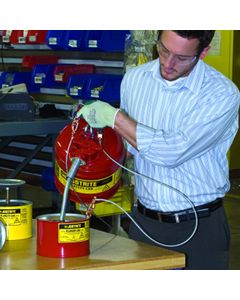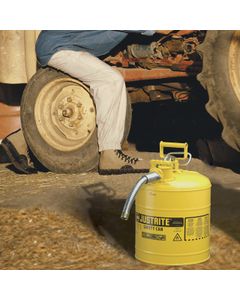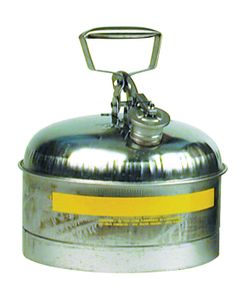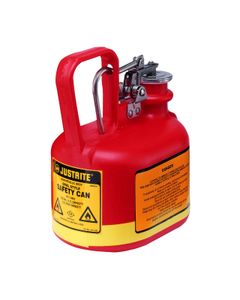Categorías
Bidones de seguridad tipo I y tipo II
Nuestras latas y contenedores de seguridad ofrecen almacenamiento seguro para líquidos inflamables en entornos de trabajo. Con nuestras latas de seguridad, los accidentes y los riesgos de incendio se minimizan, protegiendo a las personas y dando como resultado un lugar de trabajo más seguro. Las latas y contenedores de seguridad de Justrite están diseñados teniendo en cuenta los códigos de seguridad para cumplir con una variedad de diferentes regulaciones de seguridad.
Leer más

Latas de seguridad Tipo I 1001 Justrite latas seguridad RD No aplicado
Proteja a sus trabajadores y reduzca los riesgos de incendio transfiriendo, almacenando y distribuyendo líquidos inflamables en latas de seguridad con una boquilla Tipo I, aprobados por la OSHA
Disponible en 7 versiones

Latas de seguridad Tipo I 1001 Justrite latas seguridad YL No aplicado
Proteja a sus trabajadores y reduzca los riesgos de incendio transfiriendo, almacenando y distribuyendo líquidos inflamables en latas de seguridad con una boquilla Tipo I, aprobados por la OSHA
Disponible en 6 versiones

Latas de seguridad Tipo I 1001 Justrite latas seguridad BU No aplicado
Proteja a sus trabajadores y reduzca los riesgos de incendio transfiriendo, almacenando y distribuyendo líquidos inflamables en latas de seguridad con una boquilla Tipo I, aprobados por la OSHA
Disponible en 2 versiones

Type II AccuFlow™ Safety Cans 1002 Justrite Red
Go beyond protection and compliance with the added convenience of AccuFlow™ with Safe-Squeeze® trigger for safe and controlled pouring
Disponible en 4 versiones

Type II AccuFlow™ Safety Cans 1002 Justrite Yellow
Go beyond protection and compliance with the added convenience of AccuFlow™ with Safe-Squeeze® trigger for safe and controlled pouring
Disponible en 4 versiones

Bidones de acero inoxidable de tipo I 133CN Eagle
Los botes de seguridad de acero inoxidable Eagle Tipo I están construidos con acero inoxidable tipo 316 de calibre 24 con un supresor de llamas de acero inoxidable.
Disponible en 2 versiones

Bidones de seguridad de polietileno Type I 1406 Justrite latas seguridad
Los bidones de polietileno de alta densidad (HDPE) ofrecen un almacenamiento seguro para materiales corrosivos inflamables y tienen un diseño parar ahorrar espacio
Disponible en 5 versiones
FAQ about Bidones de seguridad tipo I y tipo II
What is the difference in a Type I & Type II Safety Can?
The Type I Safety Can has one opening that serves for both filling and dispensing. The Type II Safety Can has one opening dedicated to filling and a second spout opening dedicated to dispensing. The Type II Safety Can comes with an attached flexible hose and our exclusive AccuFlow™ manifold with Safe-Squeeze® trigger handle to provide the smooth and controlled pouring.
Can I transport gasoline in a safety can in my vehicle?
Yes, you can transport a safety can in a vehicle. Important points:
Secure safety can from movement.
Make sure the vehicle is well ventilated.
Do not store a safety can in a vehicle.
Take a safety can out of the vehicle when filling or dispensing.
Clean any fuel off the safety can before returning it to the vehicle
Are safety cans OK for outdoor use?
You most certainly can use safety cans outdoors. A lot of our customers do. There are some precautions to take with a safety can as well as any other container when outdoors:
1. When temperatures are hot, the vapor pressure in any safety can will be elevated. Safety cans are design to emergency pressure relief, rated at 3 to 5 psi. Still 3 to 5 psi can be significant. It is important to relieve that pressure in vapor space (while a safety can is setting flat) rather than liquid space (when tilted and dispensing liquid) to avoid a sudden burst of fluid and back splash.
2. When the temperature is warm and there is a sudden cooling, vacuum in the safety can will be created. There is no vacuum relief valve built into a safety can. While rare and depending on the fluid level in the safety can, the vacuum created can implode a safety can. This is more prevalent in desert locations. There are a couple of things you can do to prevent this:
Burp your safety cans at the end of the day to relieve pressure. The less difference in pressure, the less likely an implosion will occur.
Keep your cans shaded or tarped to minimize the temperature gain and pressure gain in the can.
Keep your safety can’s fluid level above half full.
3. Keeping your safety can in the shade can also minimize material loss. Gasoline as an example will boil at 100 degrees Fahrenheit. The pressure escaping is a liquid’s vapor escaping.
4. Always keep a safety can in a well-ventilated area. Never in a closed vehicle or passenger space.
5. And safely secure a safety can against movement in a vehicle from sudden braking or centrifugal forces.
6. Remember the US DOT’s material of trade rule as it applies to transporting gasoline in the course of performing one’s job; you are allowed a maximum of eight gallons in safety cans (i.e. 4 ea. 2 gal. safety cans).
7. Our metallic safety cans have a raised bottom to protect the bottom from puncture of sharp rocks and reinforcing ribs for resistance against side impacts.
¿Puedo almacenar nitrógeno líquido en una lata de seguridad?
Los materiales como el acero al carbón, el plástico y el caucho se vuelven quebradizos a temperaturas extremadamente bajas. El nitrógeno líquido se almacena en contenedores resistentes a impactos y especialmente aislados, que están ventilados para evitar la acumulación de presión. Esta gama de latas de seguridad NO está diseñada para almacenar nitrógeno líquido.






